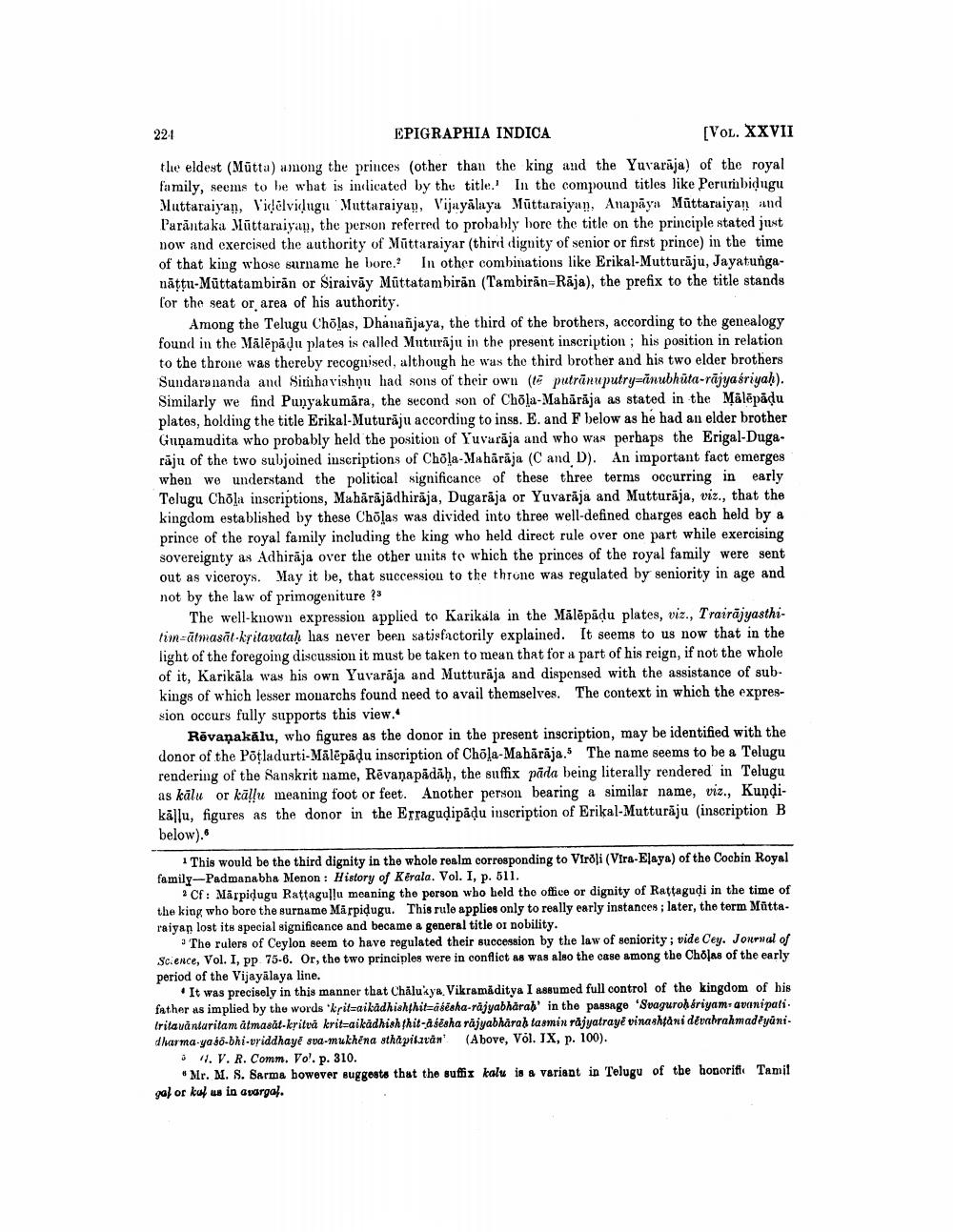________________
224
EPIGRAPHIA INDICA
[Vol. XXVII
the eldest (Mutta) among the princes (other than the king and the Yuvarāja) of the royal family, seems to be what is indicated by the title. In the compound titles like Perurbidugu Muttaraiyan, Videlvitugu Muttaraiyay), Vijayālaya Müttaraiyan, Anapaya Mūttaraiyan and l'arántaka Mūttaraiyan, the person referred to probably bore the title on the principle stated just now and exercised the authority of Mittaraiyar (thirri dignity of senior or first prince) in the time of that king whose surname he bore. In other combinations like Erikal-Mutturāju, Jayatunganáttu-Müttatambiran or Siraivāy Müttatambiran (Tambiran Raja), the prefix to the title stands for the seat or area of his authority.
Among the Telugu Cholas, Dhanañjaya, the third of the brothers, according to the genealogy found in the Mälēpádu plates is called Muturāju in the present inscription; his position in relation to the throne was thereby recognised, although he was the third brother and his two elder brothers Sundarananda and Sith havishnu had sons of their own (le putrānuputrywinubhüta-rājyasriyah). Similarly we find Punyakumara, the second son of Chõla-Mahārāja as stated in the Målēpădu plates, holding the title Erikal-Muturāju according to inss. E. and F below as he had an elder brother Guņamudita who probably held the position of Yuvarăja and who was perhaps the Erigal-Dugarăju of the two subjoined inscriptions of Chõla-Mahārāja (C and D). An important fact emerges when we understand the political significance of these three terms occurring in early Telugu Chola inscriptions, Mahārājādhiraja, Dugarāja or Yuvarāja and Mutturāja, viz., that the kingdom established by these Chõlas was divided into three well-defined charges each held by a prince of the royal family including the king who held direct rule over one part while exercising sovereignty as Adhiraja over the other units to which the princes of the royal family were sent out as viceroys. May it be, that succession to the throne was regulated by seniority in age and not by the law of primogeniture ?
The well-known expression applied to Karikala in the Mālēpădu plates, viz., Trairājyasthitim=ūtmasāt kritavatal has never been satisfactorily explained. It seems to us now that in the light of the foregoing discussion it must be taken to mean that for a part of his reign, if not the whole of it, Karikāla was his own Yuvarāja and Mutturāja and dispensed with the assistance of subkings of which lesser monarchs found need to avail themselves. The context in which the expression occurs fully supports this view..
Rēvaņakālu, who figures as the donor in the present inscription, may be identified with the donor of the Potladurti-Mälēpādu inscription of Chõla-Maharāja. The name seems to be a Telugu rendering of the Sanskrit name, Rēvanapādāḥ, the suffix pāda being literally rendered in Telugu as kālu or kāllu meaning foot or feet. Another person bearing a similar name, viz., Kundikā]lu, figures as the donor in the Erragudipadu inscription of Erikal-Mutturăju (inscription B below).
This would be the third dignity in the whole realm corresponding to Viroli (Vira-Elaya) of the Cochin Royal family-Padmanabha Menon : History of Kerala. Vol. I, p. 511.
Cf: Märpidugu Rattagullu meaning the person who held the office or dignity of Rattagudi in the time of the king who bore the surname Märpidugu. This rule applies only to really early instances; later, the term Mūttaraiyan lost its special significance and became a general title or nobility.
The rulers of Ceylon seem to have regulated their succession by the law of seniority; vide Cey. Journal of Science, Vol. I, pp 75-8. Or, the two principles were in conflict as was also the case among the Cholas of the early period of the Vijayalaya line.
It was precisely in this manner that Chalukya Vikramaditya I assumed full control of the kingdom of his father as implied by the words 'kritsaikadhishthit-atesha-rajyabharab' in the passage 'Svagurohériyam-avanipali. Irita vantaritam átmasåt-kritrā kritaikadhishthit-asisha rajyabharah tasmin rajyatrayē vinashani dēvabrahmadēyuni. dharma-yaso-bhi-vriddhayé sva-mukhena sthapilaran (Above, Vol. IX, p. 100).
11. V. R. Comm. Vol. p. 310. . Mr. M. S. Sarma bowover suggests that the suffix kalu is a variant in Telugu of the honoritid Tamil gaf or kul us in avargal.




